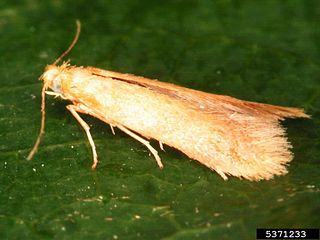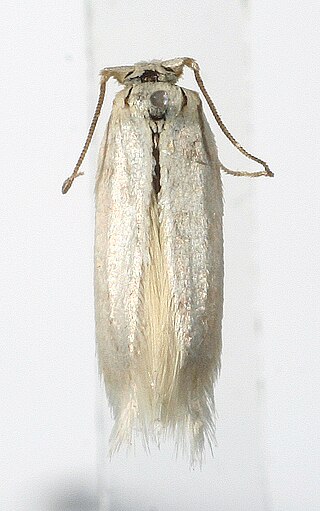
Schreckensteinioidea is a superfamily in the insect order Lepidoptera containing a single family, Schreckensteiniidae, or "bristle-legged moths", because of the stout spines on the hindlegs. The superfamily and family were both described by Thomas Bainbrigge Fletcher in 1929. The relationships of this family within the group apoditrysia are currently uncertain. One of the species, the blackberry skeletoniser, is widespread and common across Europe and has been introduced as a biological control to Hawaii, whilst three species of Corsocasis occur in South East Asia.

Neopseustidae is a small family of day and night-flying "archaic bell moths" in the order Lepidoptera. They are classified into their own superfamily Neopseustoidea and infraorder Neopseustina. Four genera are known. These primitive moths are restricted to South America and Southeast Asia. Their biology is unknown.

Nepticuloidea is a superfamily of usually very small monotrysian moths that are characterised by small or large eyecaps over the compound eyes. It comprises two families, the "pigmy moths" (Nepticulidae), with 12 genera which are very diverse worldwide and are usually leaf miners, and the "white eyecap moths" (Opostegidae), also worldwide but with five genera and about a ninth as many species, whose biology is less well known.
Palaephatoidea is a superfamily of insects in the order Lepidoptera with a single family, Palaephatidae with seven known genera. These "Gondwanaland moths" exhibit a disjunct distribution occurring mainly in South America, with four species in eastern Australia and Tasmania and one in South Africa. The larvae spin together leaves of Proteaceae (Ptyssoptera) or Verbenaceae (Azaleodes) . Palaephatoidea, a typical monotrysian group, is one two main candidates as the sister group of most of the Lepidoptera, the Ditrysia.

Tischerioidea is the superfamily of "trumpet" leaf miner moths. The superfamily contains just one family, Tischeriidae, and traditionally one genus, Tischeria, but currently three genera are recognised, widespread around the world including South America, except for Australasia. This is one candidate as the sister group of the bulk of Lepidoptera, the Ditrysia, and they have a monotrysian type of female reproductive system. These small moths are leaf-miners in the caterpillar stage, feeding mainly on Fagaceae, Asteraceae, and Malvaceae (Astrotischeria), and some also on Rhamnaceae, Tiliaceae, and Rosaceae.

Cossoidea is the superfamily of moths that includes carpenter moths and relatives. Like their likely sister group Sesioidea they are internal feeders and have spiny pupae with moveable segments to allow them to extrude out of their exit holes in stems and trunks during emergence of the adult.

Nepticulidae is a family of very small moths with a worldwide distribution. They are characterised by eyecaps over the eyes. These pigmy moths or midget moths, as they are commonly known, include the smallest of all living moths, with a wingspan that can be as little as 3 mm in the case of the European pigmy sorrel moth, but more usually 3.5–10 mm. The wings of adult moths are narrow and lanceolate, sometimes with metallic markings, and with the venation very simplified compared to most other moths.

Incurvariidae is a family of small primitive monotrysian moths in the order Lepidoptera. There are twelve genera recognised. Many species are leaf miners and much is known of their host plants, excluding Paraclemensia acerifoliella. The most familiar species in Europe are perhaps Incurvaria masculella and Phylloporia bistrigella. The narrow wings are held tightly along the body at rest and some species have very long antennae.

The Adelidae or fairy longhorn moths are a family of monotrysian moths in the lepidopteran infraorder Heteroneura. The family was first described by Charles Théophile Bruand d'Uzelle in 1851. Most species have at least partially metallic, patterned coloration and are diurnal, sometimes swarming around the tips of branches with an undulating flight. Others are crepuscular and have a drab coloration. Fairy longhorn moths have a wingspan of 4–28 millimeters, and males often have especially long antennae, 1–3 times as long as the forewing.
Cecidosidae is a family of primitive monotrysian moths in the order Lepidoptera which have a piercing ovipositor used for laying eggs in plant tissue in which they induce galls, or they mine in bark. Nine species occur in southern Africa, five species in South America and Xanadoses nielseni was recently described from New Zealand. Some minute parasitoid wasps are known.

Carposinidae, the "fruitworm moths", is a family of insects in the order Lepidoptera. These moths are narrower winged than Copromorphidae, with less rounded forewing tips. Males often have conspicuous patches of scales on either surface. The mouthparts are quite diagnostic, usually with prominent, upcurved "labial palps", the third segment long, and the second segment covered in large scales. Unlike Copromorphidae, the "M2" and sometimes "M1" vein on the hindwings is absent. The relationship of Carposinidae relative to Copromorphidae needs further investigation. It is considered possible that the family is artificial, being nested within Copromorphidae. The Palearctic species have been revised by Alexey Diakonoff (1989).
Crinopteryx is a monotypic genus of primitive monotrysian moths. Its sole species, Crinopteryx familiella, is endemic to Europe, where it is restricted to the Mediterranean region of France, Italy, the Iberian Peninsula and Sicily. Crinopteryx used to be classified in its own, monotypic family called Crinopterygidae, but the latter has been downgraded to a subfamily (Crinopteryginae) of the family Incurvariidae.

Carposinoidea, the "fruitworm moths", is a superfamily of insects in the lepidopteran order. The superfamily is also known as Copromorphoidea, which is a junior synonym. These moths are small to medium-sized and are broad-winged bearing some resemblance to the superfamilies Tortricoidea and Immoidea. The antennae are often "pectinate" especially in males, and many species of these well camouflaged moths bear raised tufts of scales on the wings and a specialised fringe of scales at the base of the hindwing sometimes in females only; there are a number of other structural characteristics. The position of this superfamily is not certain, but it has been placed in the natural group of "Apoditrysia" "Obtectomera", rather than with the superfamilies Alucitoidea or Epermenioidea within which it has sometimes previously been placed, on the grounds that shared larval and pupal characteristics of these groups have probably evolved independently. It has been suggested that the division into two families should be abandoned.
The Palaeosetidae or miniature ghost moths are a family of insects in the order Lepidoptera contained within the superfamily Hepialoidea.

Opostegidae or "white eyecap moths" is a family of insects in the order Lepidoptera that is characterised by particularly large eyecaps over the compound eyes. Opostegidae are most diverse in the New World tropics.
Prototheora is a genus of moths. It is the only genus of the Prototheoridae, or the African primitive ghost moths, a family of insects in the lepidopteran order, contained in the superfamily Hepialoidea. These moths are endemic to Southern Africa.

The Monotrysia are a group of moths in the lepidopteran order, not currently considered to be a natural group or clade. Apart from the recently discovered family Andesianidae, most of the group consists of small, relatively understudied species. The group is so named because the female has a single genital opening for mating and laying eggs, in contrast to the rest of the Lepidoptera (Ditrysia), which have two female reproductive openings. They comprise all of the group Heteroneura apart from the Ditrysia.
Andesiana is a genus representing its own family Andesianidae and superfamily Andesianoidea, the "Andean endemic moths". It contains three species with a wingspan up to 5.4 cm. in female A. similis and 3.5 cm. in males. This far surpasses in size any previously known monotrysian moth. These large Microlepidoptera are restricted to Andean South America, from where they were described originally in 1989 in the family Cossidae by their discoverer Patricia Gentili.

Cimeliidae, the gold moths, is a family of moths that is now placed in the macroheteroceran superfamily Drepanoidea, although previously placed in its own superfamily. Uniquely, they have a pair of pocket-like organs on the seventh abdominal spiracle of the adult moth which are only possibly sound receptive organs. They are quite large and brightly coloured moths that occur in southern Europe and feed on species of Euphorbia. Sometimes they are attracted to light. The family was first described by Pierre Chrétien in 1916.

Micropterigoidea is the superfamily of "mandibulate archaic moths", all placed in the single family Micropterigidae, containing currently about twenty living genera. They are considered the most primitive extant lineage of lepidoptera, and the sole superfamily in the suborder Zeugloptera. The name comes from the Greek for mikros, little and pterux, a wing. Unique among the Lepidoptera, these moths have chewing mouthparts rather than a proboscis, and are seen feeding, often in large aggregations, on the pollen of the flowers of many herbaceous plants, shrubs and trees. The fossil record of the group goes back to the middle-late Jurassic with the earliest known species being Auliepterix from the Karabastau Formation in Kazakhstan.













